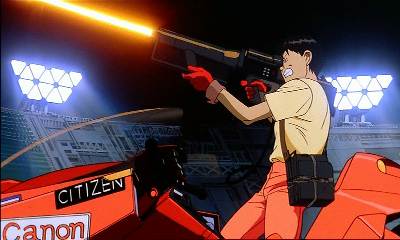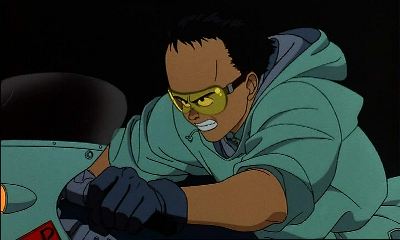AKIRA
AKIRA is apparently the ultimate power, but is it the ultimate anime?

When writing about anything it's worthwhile to establish a basepoint, and Katsuhiro Otomo's AKIRA is probably the anime most likely to be seen by us gaijins from the west.
AKIRA has gained iconic status in the anime field, and with good reason. Born out of Otomo's serialised comic of the same name, it's blend of futuristic cityscapes, biker gangs, street warfare, riots, totalitarian governments, paranormal powers and final reel lunacy proves to be a great basis for a movie version.
The film starts with a bang, showing us Tokyo being destroyed in World War Three, in 1988 (Present day Tokyo on the film's release). We cut to the reborn and rebuilt Neo-Tokyo in 2019. Inside a grungy bar we are introduced to Kaneda, leader of a gang of delinquent bike riding youths. After being informed of the location of a rival biking gang, they decide to strike against them. Outside is Tetsuo, a younger member of the gang, having a slight inferiority complex on account of this. They move out against these rivals, the Clown gang, and much violence ensues. Much of the action in this film occurs at night, which was relatively unusual at the time, and required careful selection of colours and shades to create a convincing environment. Indeed, this film used more distinct shades than any other anime in its creation, and it pays dividends. These scenes, and the entire film, still look great today with a level of subtlety rarely seen in animation.
As this unfolds, we see a strangely wrinkled and more strangely blue child being dragged through the city streets by a wounded man. They are cornered by the police, and the man is ruthlessly gunned down. The child, understandably shocked by this, screams, and all hell breaks loose. Glass breaks, buildings fall, people run for cover.
All this occurs in the first ten minutes. It ought to grab your attention, it's been designed to. It shows us the tone of the film, and gives us a little introduction as to what to expect from this film, mainly that there is more to this than just futuristic violence. Although there is quite a bit of that.
Tetsuo purses the Clowns, taking out some of them, but runs into the blue kid. Literally. The kid is unharmed, but Tetsuo and his bike are a little beat up. As Kaneda and the gang catch up with the devastation, the army arrives to reclaim the child and remove Tetsuo from the scene. The plot unfolds as experiments are carried out on Tetsuo, as it becomes clear that something has changed in him. The scientists and Colonel in charge mutter seriously about the growth pattern of AKIRA and the power of a god.
Kaneda and his gang are questioned by the police at the station, at which point Kaneda meets Kei, a young freedom fighter / terrorist, depending on your perspective. Being an inveterate skirt chaser, Kaneda fakes an alibi for her, and as a result becomes embroiled in their plots against the government and the AKIRA project, although his interest is mainly to find out what happened to his friend Tetsuo.
Throughout the film events and dialogue show that Neo-Tokyo is becoming a war zone. Anti-government protesters riot, bombs explode, police quell uprisings with extreme prejudice. At times like this, as with the bike chase scenes, the quality of the animation shines through. Smoke billows, flames flicker, blood flows and most importantly of all people move fluidly. The city is realised well, with a real depth to the cityscapes which was achieved through painstaking attention to detail. While it isn't as spectacular as the recent Metropolis, for that film they had the advantage of computer technology for creating layers of animation unheard of in 1988. The overall effect is stunning.
The sound and music plays an important part in the style of the film. The music was created by a group of artists who believe the most beautiful musical instrument is the human voice, and the choruses and arrangements they provide give the film a unique and arresting sound.
The plot does grow more obscure as conspiracies are unveiled, plots within plots develop and Tetsuo's power grows to frightening proportions, proving deadly for those that are attempting to keep a lid on him. He is tortured by bizarre hallucinations of gigantic soft toys attacking him as the name AKIRA rings through his mind. It becomes apparent to him that the strange blue children are somehow responsible for this and he seeks them out to find some answers. He does not like what the children have to say and he leaves to find the mysterious AKIRA. It becomes clear that the children are also using Kei for their purposes as well. The strands of the story combine as Tetsuo finds out whatever AKIRA is it's at the building site of the Olympic stadium. The army proves no match for Tetsuo, and as his mental state deteriorates Kaneda tries to talk some sense into him, albeit backed by a laser cannon in a final showdown.

The new translation helps greatly towards the film's conclusion. What ends up as a slightly metaphysical conclusion to the film was near incomprehensible to me in the old version, while the new translation is a lot clearer, at least as clear as such things can be. The new dubbed version is also a substantial improvement on the original, and is actually very good. This can make or break films for some people who dislike hearing the original Japanese soundtrack with English subtitles. This wouldn't deter anime buffs, but is near vital for mass-market success. The new dub is about as successful as is possible, given that the lip-synching will be ruined as a result of the change in language, however this appears to have been minimised in this version.
This film is hugely enjoyable, and it's sometimes difficult to believe it is now over fifteen years old. This is not even something to be taken into consideration when judging it. In terms of plot, sound, animation, fluidity and atmosphere it is the equal of and in many cases better than every anime available. There are very few times where the animation seems cartooney, for want of a better term. It's a strange distinction, what with it being an animation and all, but when one character gets angry and his face rapidly turns from white to red, it seems totally out of place with the tone of the rest of the film and the (relative) realism it provides. This is a very minor criticism, however. AKIRA serves not only as a great introduction to animated films from the East for those not aware of them, but also as an all time classic anime, and I feel an all time classic film.
Were I in the business of passing quantifiable judgements, I'd award this 5/5 TippyMarks.
DVD notes - There are a few different versions of AKIRA available on DVD, this review being based on last year's two disk edition (which was also available in a fetching tin, giving it the advantage of not going off until 2008).
The main 'extra' if that is the term for it is a completely redone English translation and voice over, mixed in Dolby Digital and THX approved. This is much better than the original dub, and for those with an aversion to subtitles is an absolute godsend. The film was newly transferred on to DVD from the originals for this release, digitally restored to remove dirt and scratches. The care and attention shows through. Animations can suffer more from MPEG encoding than any other film type, but this transfer has vibrant colours, no noticeable artifacting and looks as good as is surely possible.
The presentation is fantastic. The gatefold case has been printed with the use of silver spot colour, giving it a circuit board like motif. It is a well established fact that more shiny = more good. A groovy bunch of stickers are inside, featuring characters from the film and various random slogans (TM) such as ' DANGER! AKIRA is the ultimate scientific nightmare.' This professionalism is carried through to the disc menu systems, all of which are slickly done.
The main feature added on the second disc is a 50-minute documentary detailing the production design. This was made alongside the production of the film, and has not been given the same loving restoration as the film (for fairly obvious reasons). As such, the picture quality is poor and the sounds muffled, although with some the American voiceovers used muffled audio is a blessing. I level this especially at the fool who used a poor Jack Nicholson impersonation to voice one of the sound directors. Sacrilege.
The feature mainly sticks with director/writer Otomo, as he talks about AKIRA's initial development from its serialised comic form in Young magazine through to developing very detailed storyboards. The voice actors used these as they pre-recorded the dialogue before main animation, which was unusual for a Japanese production at the time. It is fascinating watching the actors play against these storyboards, many sequences of which are animated as fluidly as the main movie - an incredible feat.
The feature touches on all of the main areas of production from the art director, colourists, music and sound effects, the filming of the cell plates and also the CGI used in a few of the scenes to create the visual display of the energy fields. Near cutting edge at the time, primitive today. Given the feats achieved in Blood: The Last Vampire and Metropolis, I wonder what could have been realised with current technology.
While none of the areas are covered in depth, and it is hurt by the comparative age and general lack of polish shown throughout the rest of the disc, it will certainly be of interest to fans. Also look out for the scenes showing the original footage of the film before its DVD transfer and the original dub, which demonstrates how good the new one is.
Sadly, the rest of the extras are lacking. There is a very short stills gallery showing frames of the film and a few of the character sketches - more is shown in the production documentary. However, I have no idea how much of the original drawings survived to this day, so I'll keep my mouth shut about it. A 'direct your own trailer' thing is in there, with 8 possible clips you can reorder as you see fit. Always a good gimmick but unlikely to go back to it after a five minute fiddle.
A trivia quiz which contains some total fanboy observation questions I defy anyone to get right without cheating and getting them from the film will unlock access to a hidden area on the AKIRA website for downloading some screensaver related goodies (I believe, never tried myself). Rounding off the disc is the trailer for AKIRA and some other Manga releases, always the lamest of the lame extras. Barring interactive scene access, of course.
The restoration itself is worth buying this for, especially if you have an old VHS version to compare the transfer, and the quality of the dubs. The second disc extras provide a welcome diversion for the fans, but are mostly ignorable for the casual viewer.
Nozomu Sasaki (Tetsuo)
Mami Koyama (Kei)